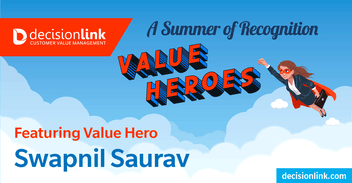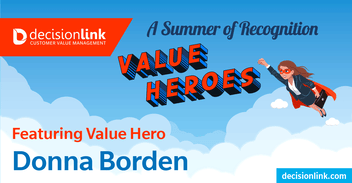The Customer Value Discipline

By Stephan Liozu, Ph.D
Putting customer value at the heart of your organization DNA requires tremendous discipline. You cannot simply adopt a value approach. You design it, you implement it, and you make sure it is assimilated and internalized at the organizational level. That includes integrating value at all phases of your go-to-market process.
A holistic and integrated value approach starts with a value-based innovation process that anchors all process, product, and service developments on creating value for customers and business partners. In that case, value means economic and financial value, i.e., cost savings and revenue generation for example! Every single dollar that is invested in the innovation process is done so to create economic value and a strong positive return for the organization. Innovation opportunities are screened on the basis on how much value they create and how much differentiation they bring to the business.

True value creation in the innovation process includes game-changing discoveries, uncovering of customers’ unmet needs through customer research, and solving customer pains through the creation of unique products, services, or software. This is not an easy proposition. Innovators must adopt and deploy the best-in-class voice-of-customer research methods such as value-in-use analysis, ethnographic research, and user-based design methods.
Creating a value discipline in the innovation process makes the rest of the value management process somewhat easier. Differentiated and value-based innovations can be marketed based on how much economic value they create for a specific customer of entire market segments. Marketers oversee documenting value and creating the value toolbox, which might include value propositions, value stories, value calculators, and a value playbook. Pricing teams support the customer value deployment by enabling value-based pricing strategies and calculating the differential economic value in dollars and cents that can be shared with and captured from customers. Then, sales teams are trained on value-based selling methods using all the value tools available in the toolbox and delivering impactful value messages. At the very end of the customer value approach, value-based negotiations increase the rate of value capture and value realization levels over time.
The alignment of all go-to-market functions is essential in successful customer value management (CVM) programs. But this is not all. In addition to the functional buckets of the go-to-market, there are three steps in the CVM process that overlap with the go-to-market functions as shown below:

First, customer value is created through innovation and marketing activities. Then, customer value is quantified using various methods such as total cost of ownership (TCO), ROI calculators, and economic value estimation models (EVE®). And finally, customer value is captured by suppliers and shared with partners and customers through pricing strategies and tactics. The simple graph above depicts the complex role of a Chief Value Officer or any customer value executive. That person is the guardian of the customer value galaxy, crisscrossing the organizational universe to make sure the customer value discipline is alive and well.
Specifically, there are five things that are critical for customer value journeys:
- Developing cross-functional collaboration: That is a given. It is all hands-on deck for all functions that have customer-facing activities. Silos go down and people put the customers at the center of their daily work.
- Developing the tools and process that allow for industrialized activities: The goal here is to move away from the manual process of building customer value proposition one-by-one in PowerPoint or value calculations in Excel. There are digital tools that can accelerate the management of the CVM steps and activities. The use of these tools in conjunction with a robustly designed and agile CVM process can do miracles!
- Reinforcing the need to focus on customer value in the business through the process: CVM is not just a process. It needs to bring value to the organization and to the business units. So, we cannot just follow the process. It is business impact first, process second. Because value is shared with customers, impact must be delivered and realized jointly.
- Ensuring that mindset change is happening and that it is irreversible: Repetition, repetition, and more repetition. For most organizations, CVM is a new muscle that they must develop. To build that muscle, teams need to engage in CVM activities, practice and repeat the steps until it is absorbed into their daily routine. The end goal is to have people discuss customer value each day without having to ask to do so. It should be part of their DNA.
- Making customer success the heart of the CVM process: We are in business to succeed. So are our customers. The more in alignment we are with our customer goals, strategic priorities, and outcomes, the better the results are for all parties involved. The more our customers succeed, the more we succeed. It is as simple as that! This is one of the reasons why usage-based pricing is becoming more and more popular in the SaaS world and outcome-based pricing is booming in the service world.
The customer value revolution is real, and it’s here. More software companies are investing in value management and customer success teams. More product companies are adopting and embracing value-based strategies and concepts. Make sure that customer value management is managed holistically in your organization and that the process is managed efficiently and successfully!
Bio

Stephan Liozu (www.stephanliozu.com) is the Founder of Value Innoruption Advisors (www.valueinnoruption.com), a consulting boutique specializing in industrial pricing, digital business, and value models, and value-based pricing. Stephan has 30 years of experience in the industrial and manufacturing sectors with companies like Owens Corning, Saint-Gobain, Freudenberg, and Thales. He holds a Ph.D. In Management from Case Western Reserve University, and has written several books, including “Dollarizing Differentiation Value” (2016) and “Value Mindset” (2017).

 ValueCloud
ValueCloud
.png?width=118&height=76&name=Rectangle%20(3).png) ValueCloud Ignite
ValueCloud Ignite
.png?width=92&height=92&name=Rectangle%20(4).png) Free Assessment
Free Assessment
.png?width=100&height=100&name=Rectangle%20(5).png) Watch a Demo
Watch a Demo
.png?width=82&height=96&name=Rectangle%20(6).png) Value Calculator
Value Calculator

.png?width=62&height=51&name=Group%2010%20(1).png) Marketing
Marketing
 Sales
Sales
 Customer Success
Customer Success
 Engage Prospects
Engage Prospects
 Win Deals Faster
Win Deals Faster
 Retain Customers
Retain Customers
.png?width=62&height=62&name=Rectangle%20(8).png) Adopt and Scale
Adopt and Scale
.png?width=54&height=54&name=Rectangle%20(9).png) Cybersecurity
Cybersecurity
 Healthcare
Healthcare
.png?width=54&height=54&name=Rectangle%20(10).png) IT & Software
IT & Software



